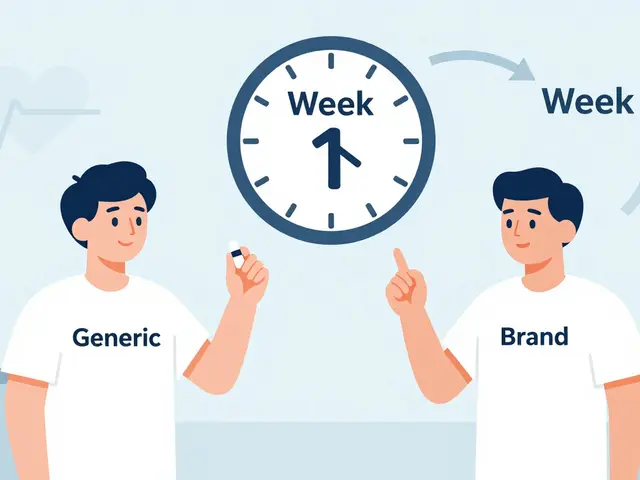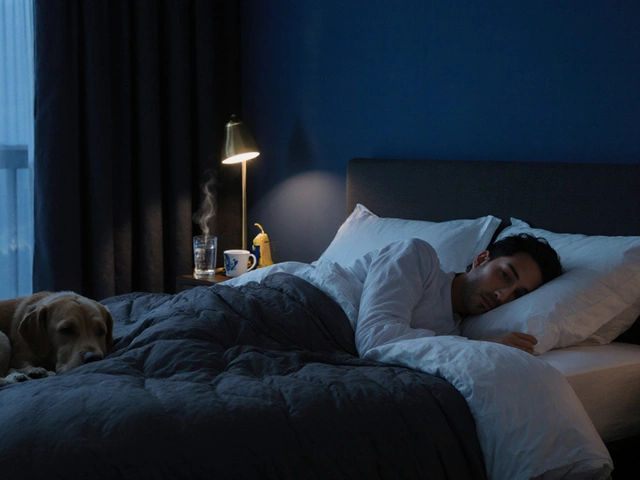Let's face it, migraines are a real pain. If you're relying on Sumatriptan and it's just not doing the trick, you're probably itching to find something that actually works. And hey, you're not alone. Migraines can really mess with your life, so understanding your options is totally worth your time.
Whether you're looking for something to cut down on the frequency of those headaches or just want a reliable backup plan, knowing what's out there could save you a lot of hassle. Today, we're diving into nine alternatives that could be your new best friend in the migraine department.
- Botox (OnabotulinumtoxinA)
- Magnesium Supplements
- Acupuncture
- Riboflavin (Vitamin B2)
- Feverfew
- Butterbur
- Cognitive Behavioral Therapy (CBT)
- Biofeedback
- Herbal Teas
- Conclusion
Botox (OnabotulinumtoxinA)
So, Botox isn't just a beauty hack for wrinkles—it turns out it's also a hero for tackling chronic migraines. Crazy, right? By targeting the nerve signals in your head and neck, Botox actually helps prevent those nasty headaches from keeping you down.
What's really cool is that Botox is FDA-approved for migraines, which makes it a solid option if you’re regularly feeling like your head’s about to explode. Many people find it works best for frequent, long-lasting migraines. And once it kicks in, you could have up to three or four months of fewer migraines. Talk about peace of mind!
Pros
- Effective for chronic migraines.
- The effect lasts about three to four months, which means less worry about frequent treatments.
- FDA-approved for migraine treatment, giving it that stamp of trustworthiness.
Cons
- It's not for those sudden, out-of-the-blue migraine attacks.
- You have to get it injected, which isn’t everyone’s cup of tea.
- The cost can be pretty steep; it's not the cheapest option out there.
Now, it’s worth mentioning that while Botox can be pricey, insurance often helps cover the cost if it's deemed necessary for treating chronic migraines. So, it's worth checking in with whoever handles your medical costs to see if Botox could be more affordable than you think. After all, when those migraine-free months come your way, you'll likely feel it's priceless.
Magnesium Supplements
Now, let's chat about magnesium supplements. These little guys are important because having enough magnesium in your body can actually help reduce migraine attacks. It's not just a random mineral; it plays a crucial role in regulating brain signals.
Studies show that a lot of folks who suffer from migraines have lower levels of magnesium. So, boosting your intake through supplements might make a big difference. It's like giving your brain the nutrients it craves to cut down on those painful episodes.
Pros
- May reduce migraine frequency and severity.
- Generally safe and available over-the-counter.
- Also supports other bodily functions like muscle and nerve function.
Cons
- Can cause digestive issues in some people (think diarrhea—fun, right?).
- Effectiveness can vary from person to person.
- Takes time to show results; it's not a quick fix.
Experts typically recommend a daily intake of around 400 mg, but it's always smart to chat with your doctor first. Why? Because going overboard isn't good either and can mess up the balance of other minerals in your body.
So, could magnesium supplements be your ticket to fewer migraines? They might just be. And the best part? You don't need a prescription and it's relatively cheap. Just keep an eye on how much you're taking, and you might find things looking a whole lot brighter.
Acupuncture
Acupuncture might seem like ancient news, but it's still trendy in the world of alternative medicine, especially when we're talking about migraine relief. This method involves sticking super-thin needles into specific points on your body. Sounds a bit odd, but many folks with migraines swear by it.
The cool part? Acupuncture can help reduce the frequency and intensity of migraines, turning those brain-splitting headaches into more manageable experiences. It's thought to work by releasing pain-relieving chemicals in the brain and helping the body find its balance. Plus, the treatment sessions are pretty relaxing—more like a zen retreat than a doctor’s visit.
Pros
- Non-invasive and low-risk compared to meds.
- Can complement other migraine treatments.
- Sessions might help with overall relaxation and stress reduction.
Cons
- Results can vary from person to person.
- Need regular sessions, which can add up cost-wise.
- Some people are squeamish about needles.
An interesting stat: a study showed about 50% of people who try acupuncture experienced a noticeable reduction in migraine days. But remember, acupuncture isn't a miracle cure. It's great as part of a broader approach to managing migraines. So, if you're considering giving it a shot, it's probably worth chatting with a healthcare professional who can guide you through what to expect and see if it's the right path for you.
Riboflavin (Vitamin B2)
If you're tired of reaching for the usual migraine meds, Riboflavin, also known as Vitamin B2, might just be worth a shot. It's one of those things your body can’t produce on its own, so you need it from foods or supplements. Here's a cool fact: Riboflavin is known for helping your body produce energy and break down fats, drugs, and steroid hormones. But what really makes it interesting is its potential impact on migraines.
Studies have shown that taking 400mg of Riboflavin daily can reduce migraine frequency. That's right – fewer headaches and a bit more peace in your life. It's also considered pretty safe with minimal side effects. You might get neon yellow pee (no joke!), but that's just your body flushing out extra.
Pros
- May reduce migraine frequency over time.
- Generally well-tolerated with few side effects.
- Easy to find in supplement form or in foods like eggs and dairy.
Cons
- Consistency is key, as it may take a couple of months to see results.
- Effectiveness can vary from person to person.
- Not a quick solution for acute migraine attacks.
While it might not replace Sumatriptan for immediate relief of migraine attacks, adding Riboflavin to your daily routine could be a step in the right direction for long-term management. And hey, stocking up on eggs and almonds doesn’t seem so bad, right?
Feverfew
If you're tired of taking pills and are looking for something more natural for your migraine arsenal, Feverfew might just become your new pal. This daisy-like plant has been around for ages, with its roots in traditional medicine. It's especially enticing because you can simply drink it as a tea or take it as a supplement. So, how does it stack up in relieving those pounding headaches?
Feverfew contains a compound called parthenolide, which some folks say can ease migraines by reducing inflammation and calming blood vessels. Sounds promising, right? Its fans claim that regularly taking this herb can lessen migraine frequency and severity. It's a bit like prepping your defenses so those migraines have a harder time hitting.
Pros
- Natural option with a long history of use.
- May reduce migraine frequency when taken consistently.
- Available in several forms, including teas, capsules, and extracts, making it easy to fit into your routine.
Cons
- Won't provide instant relief for acute attacks; it's more preventative.
- Not all studies agree on its effectiveness, so results can be hit or miss.
- Possible side effects like mouth ulcers or digestive issues if used in excess.
If you're considering adding Feverfew to your migraine strategy, it's worth chatting with your healthcare provider, especially since it's not a one-size-fits-all solution. They can help ensure it won't mess with any other meds you're on. But for those who have tried and tested this herb, it could be a gentle nudge towards fewer migraine days.

Butterbur
Butterbur might sound like an ingredient from an old-school herbal remedy, and you wouldn't be too far off. It's a plant that folks have been using for ages to deal with headaches and other ailments. Nowadays, it's catching some attention as a potential alternative for those who find Sumatriptan isn't hitting the mark.
Butterbur is known for its ability to head off migraines before they start. What makes it tick? The plant contains compounds that can reduce inflammation and spasms in blood vessels, which are common migraine triggers. But be careful, not just any butterbur will do. You need to look for PA-free labels. That's because raw butterbur can contain harmful alkaloids. You definitely want to avoid those.
Pros
- Can prevent migraines from happening.
- Natural alternative to pharmaceuticals.
- Reduces inflammation, a key migraine trigger.
Cons
- Quality concerns: Need for PA-free options.
- Potential side effects like dizziness or digestive issues.
- May interact with other medications, so talk to your doc.
Is it effective? People using butterbur have reported needing fewer days off due to migraines. But like all alternatives, it’s not for everyone. If you're thinking about giving butterbur a shot, make sure you get the go-ahead from a healthcare pro. It's great having options, but you want them to be the right ones.
Cognitive Behavioral Therapy (CBT)
Ever thought about tackling migraines without popping pills? Cognitive Behavioral Therapy (CBT) is a cool approach that might interest you. It’s all about changing how your brain reacts to stress, which, surprise surprise, plays a big part in migraine intensity and frequency.
CBT helps you understand the patterns between your thoughts, feelings, and behaviors, and importantly, how these can trigger or worsen your migraine episodes. By breaking this cycle, CBT aims to give you a bit of control back – who doesn't want that?
But what makes CBT stand out in the sea of migraine treatment options? For starters, it's not just about sitting in a therapist's office and unloading your thoughts. Instead, you'll learn practical coping strategies tailored to your migraine experience. Whether it’s about managing stress, improving sleep, or even dealing with the emotional impact of chronic migraines, there’s a lot you can pick up.
Check out some of the pros and cons:
Pros:
- Drug-free approach – thumbs up for those who want alternatives to medication like Sumatriptan.
- Addresses psychological and physical aspects of migraines.
- Can improve overall mental health, which is linked to reduced migraine frequency.
Cons:
- Requires commitment over time; not a quick fix.
- Might not be covered by insurance, so check your plan.
- Finding a qualified CBT therapist might take some legwork.
Feeling daunted? Don't be. Therapists say often it takes only a few sessions to start seeing real changes, especially when tackling chronic migraines. Plus, many CBT techniques can be used anytime, offering ongoing empowerment long after the therapy sessions are over.
| Aspect | Details |
|---|---|
| Session Duration | Typically 45-60 minutes |
| Common Techniques | Mindfulness, relaxation exercises |
| Success Rate | Reported improvement in 50-60% of people with chronic migraines |
So, if you're tired of reaching for pills and want a more hands-on approach to dealing with your migraines, CBT could be a game changer.
Biofeedback
Ever heard of turning your body into its own therapist? That's kind of what biofeedback does. It's all about tapping into the power of your mind to help control your body's responses. Sounds pretty sci-fi, right? But it's actually a pretty neat, evidence-based technique for those battling chronic migraines.
Biofeedback involves using sensors that monitor bodily functions—think muscle tension, heart rate, or skin temperature—and displays them in real time. You're basically seeing how stress or pain affects your body, and then you learn how to control those responses. Over time, with practice, this can help reduce the frequency and intensity of migraines.
Here's a quick breakdown of how it works:
- Identify stressors: Once you see how your body reacts to stressors, it's easier to pinpoint triggers.
- Develop control: Using mental exercises, you practice reducing stress responses by, say, slowing your heart rate or relaxing tense muscles.
- Apply it in real life: With time, you can use these techniques outside of sessions to manage migraine triggers before they escalate.
Now, you might be thinking, "This sounds great, but does it really work?" Studies suggest that biofeedback can significantly decrease the number of migraine days and lessen their severity. In fact, some folks even pair it with other treatments like magnesium supplements or cognitive behavioral therapy to amplify benefits.
Of course, every rose has its thorn. It requires time, patience, and often the guidance of a healthcare professional. Also, the effects can be a bit subjective, varying from person to person. Yet, for many, the trade-off is worth the potential for cutting back on medications like Sumatriptan.
In a nutshell, while biofeedback isn't a quick fix, it could be a valuable piece of the puzzle in your migraine management toolkit, especially if you're keen on exploring alternatives without jumping straight to meds.
Herbal Teas
When it comes to soothing those pounding headaches, herbal teas might just be your new go-to cup of comfort. They're like a warm hug in a mug for migraine sufferers looking for some natural relief.
So, what's the deal with herbal teas? Certain herbs have properties that can help ease tension, reduce inflammation, and promote relaxation—pretty much a trifecta for anyone in migraine misery. Among the standout options are ginger tea, peppermint tea, and chamomile tea.
Ginger tea packs a real punch against migraines. It's been known to help with nausea, which often tags along with migraines, and it's pretty good at promoting overall relaxation.
Peppermint tea is another star player. The menthol in peppermint has a cooling effect that can help relax the muscles and ease headache tension. Plus, the aroma alone can be quite soothing.
Last but not least, let's talk about chamomile tea. This one's a classic for a reason. It's famous for its calming effects and is often recommended for reducing stress—something every migraine sufferer can appreciate.
Now, it's not all rainbows and butterflies with herbal teas. If you're trying them for the first time, it might take a bit of trial and error to figure out which one works best for you. Also, always keep an eye out for allergies, and consult your doctor if you're unsure about how these herbs might interact with medications you're already taking.
It's pretty fascinating how soothing a cup of tea can be during those tough migraine times, right? It's not just about the herbs themselves but the ritual of making and drinking tea which can be a comforting distraction, too.
Conclusion
Navigating through all these alternatives to Sumatriptan can be a bit overwhelming, but the key is finding what fit best for you. Each option is unique, offering different ways to tackle those dreadful headaches. Some might help reduce how often your migraines strike, while others could ease the pain once it starts.
It's good to remember that not every solution will work for everyone. Your buddy might swear by Botox, while you find relief in a steamy cup of herbal tea or through regular acupuncture sessions. And there's no harm in experimenting a bit with guidance from a healthcare provider.
Here's a quick comparison to see what we've talked about:
| Alternative | Pros | Cons |
|---|---|---|
| Botox | Effective for chronic migraines, long-lasting | Not for acute attacks, high cost |
| Magnesium | Natural, helps reduce frequency | Requires consistent use, digestive issues |
| Acupuncture | Anecdotal success, relaxation benefits | Time-consuming, variable effectiveness |
| Riboflavin | Reduces frequency, easy to find | Might take weeks to see results |
As you consider these alternatives, keep in mind the need to consult with a healthcare pro before making changes to your treatment plan. They can help ensure that whatever route you take, it's both safe and suited to your personal health needs. Ultimately, the right approach for tackling migraines might be a combination of methods that align with your lifestyle and offer effective relief.



 Medications
Medications





Tim Ferguson
July 18, 2025 AT 12:45Ah, the classic migraine saga! If Sumatriptan isn’t your hero, maybe the whole story of migraines needs a rewrite. Some say Botox works wonders, some swear by avoiding screens, and then there’s the whole ritual of adding ginger tea into your life. But honestly, is there a one-size-fits-all solution? Probably not.
What if migraines are not just some curse but a call to rethink our lifestyles fundamentally? You can medicate endlessly, but does that fix the root cause? Also, have you considered how placebo effects and mindsets might play a bigger role than we give credit for? Or is it all just biology wrapped in some medical jargon?
Anyway, sharing options is great, but maybe the bigger question is what these migraines teach us about ourselves and our modern living.
Brian Jones
July 19, 2025 AT 22:05Oh, definitely agree with the need to explore beyond Sumatriptan! It’s like, our little migraine companions demand a holistic approach, right? Botox is interesting, yes, and lifestyle changes absolutely can be game changers, but let’s not forget the patient’s mindset here!!!
Understanding one’s triggers and responses to treatment unlocks mental clarity that can almost magically uplift one’s quality of life. This whole process is like peeling an onion—lots of layers, tears, but eventual clarity!
Plus, we’re all unique ecosystems of neurochemistry and habits. What works for one might be a disaster for another. So keep experimenting, but don’t lose faith or patience!!!
Johnson Elijah
July 21, 2025 AT 16:22Hey folks!! Just chiming in with tons of positivity here 😊😊 Migraines are brutal, but the options beyond Sumatriptan could really have some untapped potential! Botox, for example, while often overlooked outside dermatology, shows remarkable promise to some people. And the power of lifestyle changes can’t be underestimated!!!
Exercise, diet, hydration, mindfulness practices – all these small tweaks sometimes add up to big relief. And… hey, sometimes it’s about embracing a community that gets it, so you’re not fighting this battle alone!!!
What’s everyone’s take on non-pharmaceutical approaches, and how willing are people to explore them?
Anastasia Petryankina
July 23, 2025 AT 10:35You know, it’s almost fashionable now to jump onto the Botox train as if it’s some kind of miracle panacea, right? Meanwhile, Sumatriptan goes quietly about its business, being the tried-and-true ‘classic’ it is. I mean, sure, alternatives exist but they come with that alluring smog of overhyped promises and side effects.
Individuals searching for relief deserve more than just trendy medical fads. The post skimmed the surface, but really the nuances of each treatment—cost, accessibility, efficacy, and that old favorite, the patient’s lifestyle—need deep inspection. Until then, we’re just chasing shadows under the migraine moon.
Anyway, keep chasing your tails, friends.
Carlise Pretorius
July 24, 2025 AT 19:55thanks for sheding light on sumatriptan alternatives, honestly one of my fav things to chat about, its so important to know that there’s options especially when it dont work for people. botox is something a few ppl i know tried and found relief, but then there’s the whole other side - how u gotta keep up with it and the cost etc is major.
lifestyle changes, its mad how much effect simple things can have, like staying hydrated and reducing stress. they might sound basic but sometimes its the basics that do wonders. would be cool if more docs talked about combining meds with lifestyle, makes more sense than just pushing pills.
Bridget Dunning
July 26, 2025 AT 10:48Indeed, the exploration of alternatives to Sumatriptan is pivotal for those suffering excruciating migraines. Besides the aforementioned Botox and lifestyle adaptations, one must not overlook emerging therapies such as CGRP inhibitors, which have shown promising clinical efficacy in migraine prophylaxis, though their accessibility and cost remain barriers.
Furthermore, integrating comprehensive behavioral therapy—mindfulness meditation and cognitive behavioral therapy—can remarkably modulate migraine frequency and severity. These approaches underscore the biopsychosocial nature of migraine disorders.
The post admirably opens discourse for individualized treatment paradigms, which is essential in a condition as multifaceted as migraines.
Roxanne Lemire
July 28, 2025 AT 01:42i read about cgrp blockers too, dont rly know much but they seem like an interesting new class. wonder if insurance covers them though, that can be a major problem. also, how do peeps feel about combining meds with lifestyle stuff, cause that sounds like it would be better than just meds alone.
if sumatriptan isnt working, maybe switching is worth it, but i heard some people get side effects from alternatives? would appreciate hearing from those who tried other stuff.
Alex Mitchell
July 29, 2025 AT 16:35Just to add here, the question of balancing efficacy with quality of life can't be overstated. If Botox works but means a monthly clinic visit and discomfort, is that actually better? For me, it's about finding what fits best into your daily routine and mental well-being.
On that note, combining meds with mindfulness or biofeedback therapy can sometimes lessen dependency on anything pharmaceutical. Have any of you tried these combined approaches? Would love to hear some success stories or even challenges.
Ashley Helton
July 31, 2025 AT 13:02Couldn't agree more about the holistic aspect! It's easy to get lost in the maze of meds, but the power of understanding your own triggers and responses is underrated. Also, sometimes that friendly, sarcastic nudge towards lifestyle changes is what jolts people to act.
Like, if you can squeeze in a quick meditation or ditch the afternoon caffeine, that's a win. And yeah, it’s annoying but patience is key—finding the right combo is often trial and error.
Anyone else feel like their migraine journey is as much about mental resilience as physical treatment?
Dominic Dale
August 2, 2025 AT 12:15Look, while we discuss Botox and fancy new drugs, what if the real culprit is some pharmaceutical conspiracy aiming to keep us hooked? Ever wondered why alternatives are ‘explored’ only after people report issues with Sumatriptan? What if Big Pharma’s interest lies in maintaining dependency on particular treatments? The timing of new ‘miracle’ drugs released while older ones lose popularity is suspicious, if you ask me!
I’m not here to make you paranoid, but open your eyes before blindly accepting what’s fed from the medical industry shelves. Alternatives are good—yeah, sure—they give an illusion of choice. But digging deeper reveals layers of economic interests beyond your migraine relief.
Gary Smith
August 17, 2025 AT 12:45This is all overcomplicated nonsense. You want relief, you go with what works and what’s FDA approved. Botox? Lifestyle changes? Give me a break. If Sumatriptan isn’t cutting it, then maybe you just have a tougher condition that needs a specialist. Don’t waste time chasing gimmicks!
Simple: Talk to your doctor, get proper diagnosis, and stick with evidence-based medicine. None of this guesswork or holistic mumbo jumbo. It’s healthcare, not a hobby.